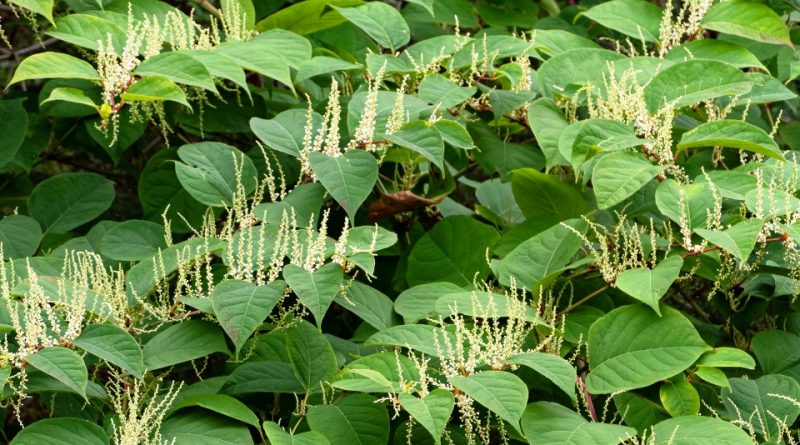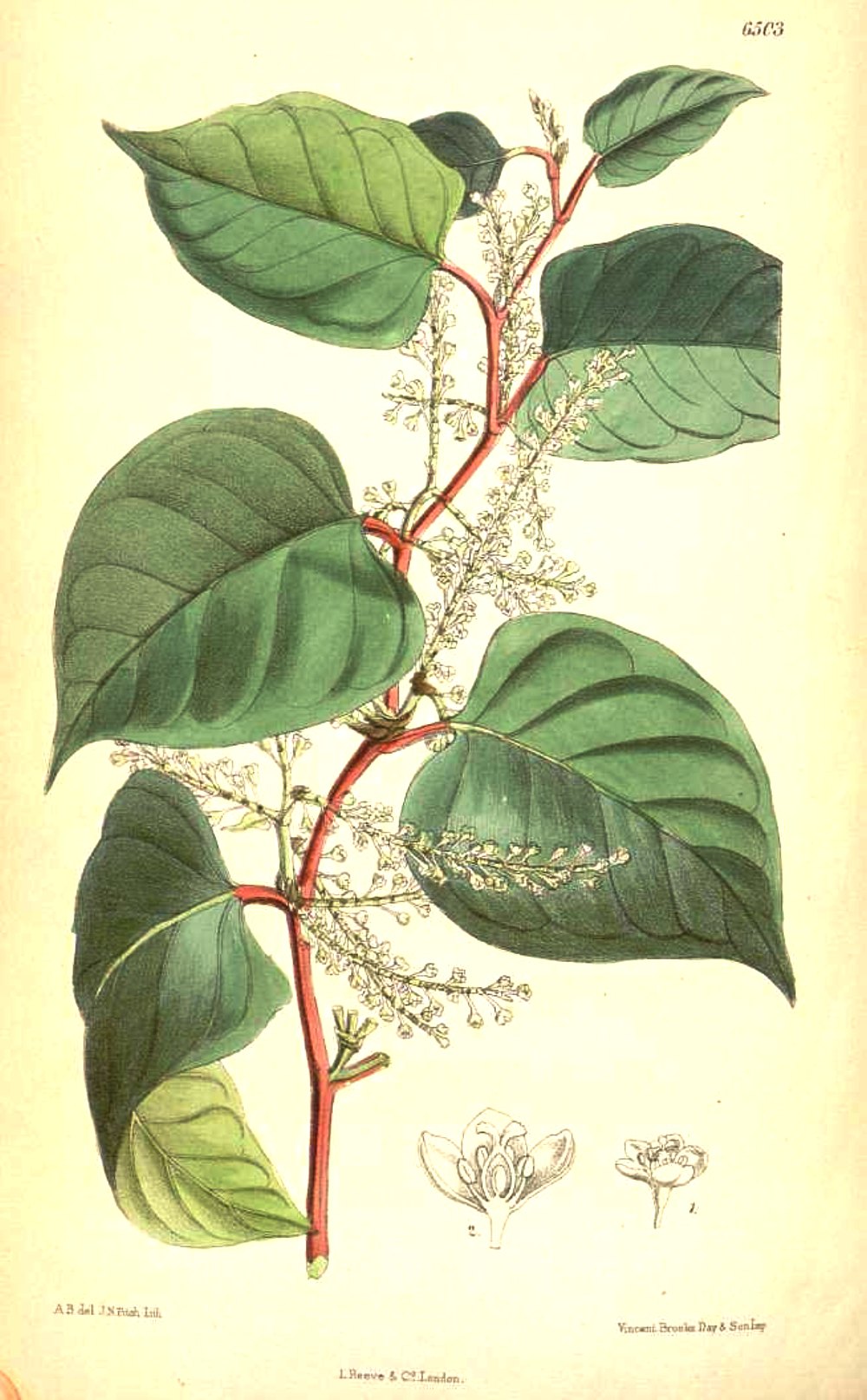Reynoutria japonica
Reynoutria japonica
The Japanese Knotweed (Reynoutria japonica Houtt.) is a perennial herbaceous species belonging to the Polygonaceae family.
Systematics –
From a systematic point of view it belongs to:
Eukaryota Domain,
Kingdom Plantae,
Subarign Tracheobionta,
Magnoliophyta Division,
Magnoliopsida class,
Subclass Caryophyllidae,
Polygonales Order,
Polygonaceae family,
Genus Reynoutria,
R. japonica species.
The following terms are synonymous:
– Fallopia compacta (Hook.f.) G.H.Loos & P.Keil;
– Fallopia japonica (Houtt.) Ronse Decr .;
– Pleuropterus cuspidatus (Siebold & Zucc.) H. Gross;
– Pleuropterus zuccarinii (Small) Small;
– Polygonum compactum Hook.f .;
– Polygonum cuspidatum Siebold & Zucc .;
– Polygonum hachidyoense Makino;
– Polygonum reynoutria Makino;
– Polygonum zuccarinii Small;
– Reynoutria hachidyoensis (Makino) Nakai;
– Reynoutria hachijoensis Nakai ex Jôtani;
– Reynoutria hastata Nakai ex Ui;
– Reynoutria henryi Nakai;
– Reynoutria uzenensis (Honda) Honda;
– Reynoutria yabeana Honda;
– Tiniaria japonica (Houtt.) Hedberg.
Etymology –
The term Reynoutria of the genus was dedicated to the Flemish nobleman Karel van Sint-Omaars (1533-1569), botanist and humanist, lord of Dranouter (Frenchized in de Reynoutre).
The specific japonica epithet as a species related to Japan.
Geographic Distribution and Habitat –
Reynoutria japonica is a perennial herbaceous plant native to East Asia, Japan, China and Korea.
This plant has naturalized in North America and Europe, in numerous habitats and is classified in several countries as a weed and invasive species.
In Italy it was introduced in the Botanical Garden of Padua around the middle of the nineteenth century as an ornamental plant; later it was also cultivated for soil consolidation interventions and its spontaneous presence is documented since 1875, and since then the species has begun to expand in an alarming way; today it has been reported for all the regions of northern Italy, even at high altitudes in the Alps. The regional distribution, still incompletely known, appears fragmentary, extending continuously from the Trieste Karst to the eastern Friuli high plain, with scattered stations in the sector alpine and in the western Friuli plain.
Its preferential habitat is that of in ruderal environments, near the streets and along the waterways, spreading rapidly along the banks thanks to the current that carries fragments of the rhizomes.
In its places of origin it is found in humid grassy places and in the plains.
Description –
Reynoutria japonica is a dioecious herbaceous perennial that features hollow stems with distinct raised nodes that give it the appearance of bamboo. The stems can reach a maximum height of 3-4m for each growing season.
The leaves are oval in shape with a truncated base, 7-14 cm long and 5-12 cm broad and with an entire margin.
The flowers are small, cream or white, produced in erect racemes 6–15 cm long.
The antesis runs from June to September.
The fruit is a diclesium with ovoid or ellipsoid achene, trine of about 4 (5) x 3 mm, included in the persistent perianth, blackish when ripe.
Cultivation –
Reynoutria japonica is a perennial plant that is harvested in nature for local use as a food, medicine, and source of materials.
It is an extremely invasive plant capable of emitting new shoots at a considerable distance from the main head and also growing through the asphalt and that in the dense vegetation that forms a very suitable habitat for spiders, insects, frogs, snakes and many other species.
It is a very cold hardy plant, able to tolerate temperatures down to around -25 ° C when in a dormant state.
It is a very easy plant to grow that grows in many types of soil although it prefers moist soil and partial shade.
Propagation can take place by seed which must be sown in spring. Germination is usually abundant.
It can also propagate by division in the spring or autumn period.
Where this plant is introduced it tends to form dense and dense colonies that completely exclude any other herbaceous species and is now considered one of the worst invasive alien species in some countries.
The species’ success has been attributed in part to its tolerance to a very wide range of soil types, pHs and salinities.
Furthermore, the invasive root system of this plant and the strong growth can damage concrete foundations, buildings, defenses against floods, roads, pavements, retaining walls and architectural sites and can also become a problem in the water circulation of canals.
Customs and Traditions –
The Japanese knotweed is a plant that, especially in the past, was used both as a food and medicinal plant.
This plant grows widely throughout Japan and is harvested as an edible wild vegetable.
Here it is called with the local names of: tonkiba (Yamagata), itazuiko (Nagano, Mie), itazura (Gifu, Toyama, Nara, Wakayama, Kagawa), gonpachi (Shizuoka, Nara, Mie, Wakayama), sashi (Akita, Yamagata ), jajappo (Shimane, Tottori, Okayama) and sukanpo in other areas.
For edible use, the young shoots that sprout in spring are used, cooked and can be used as a substitute for asparagus. They have an acidic taste and can also be used as a substitute for rhubarb in cakes, fruit soups, jams, etc.
The stems and tips of older shoots can also be eaten cooked and taste like a mild version of rhubarb.
The seeds can be eaten both raw and cooked, although they are very small and impractical to use.
The seeds can also be ground into a powder and used as a flavoring and thickener in soups, etc., or they can be mixed with grains to make bread, desserts, etc.
The roots are also sometimes eaten.
The plant is consumed in Japan as a sansai or wild vegetable.
In some areas, such as on the island of Shikoku, as in the central parts of Kagawa prefecture, the peeled young shoots are pickled and in salt mixed with 10% nigari (magnesium chloride).
In the city of Kochi it is customary to rub these clean shoots with a mixture of coarse salt and nigari. It is said (although no source is cited) that the magnesium in nigari binds to oxalic acid, thereby mitigating its risk.
In medicine the roots are used which are: anti-inflammatory, bechiche, purifying, diuretic, emmenagogue, emollient, febrifuge, stomachic and vulnerary.
This plant is used in traditional Chinese and Japanese medicine to treat various ailments through the action of resveratrol, although there is insufficient evidence for any medical efficacy.
Resveratrol extracts from R. japonica roots have a higher content than those from stems or leaves and have higher levels at the end of the growing season.
They are used in the treatment of female periodic disorders.
A decoction is used in the treatment of burns, boils and abscesses, poisonous snake bites, acute hepatitis, appendicitis, traumatic injuries and menstrual irregularities.
The leaves can be crushed and applied externally as a poultice on abscesses, cuts, etc., while the dried roots can be ground into a powder and applied externally.
The extracts of the plant showed anticancer activity.
Among other uses, it should be remembered that the Reynoutria japonica was used for agroforestry uses, however, forming a ground cover that makes any other vegetation difficult; however these plants are potentially a good source of biomass.
Among other uses, it should be remembered that a yellow dye is obtained from the root.
Furthermore, the flowers of this plant are appreciated by some beekeepers as an important source of nectar for bees, at a time of year when little else is blooming. A unifloral honey is obtained, usually called bamboo honey by beekeepers in the northeastern United States.
Preparation Method –
The Japanese knotweed is a plant that uses everything from roots to seeds.
It is used in the food and medicine fields.
Above all, the tender parts of the plant are consumed like a real vegetable while for medicinal use decoctions are prepared in the treatment of burns, boils and abscesses, poisonous snake bites, acute hepatitis, appendicitis, traumatic injuries and menstrual irregularities.
The leaves can be crushed and applied externally as a poultice on abscesses, cuts, etc., while the dried roots can be ground into a powder and applied externally.
The seeds are eaten both raw and cooked and can also be ground into a powder and used as a flavoring and thickener in soups, etc., or they can be mixed with grains to make bread, desserts, etc.
The roots can also be consumed.
Guido Bissanti
Sources
– Acta Plantarum – Flora of the Italian Regions.
– Wikipedia, the free encyclopedia.
– Useful Tropical Plants Database.
– Conti F., Abbate G., Alessandrini A., Blasi C. (ed.), 2005. An annotated checklist of the Italian vascular flora, Palombi Editore.
– Pignatti S., 1982. Flora of Italy, Edagricole, Bologna.
– Treben M., 2000. Health from the Lord’s Pharmacy, Advice and experiences with medicinal herbs, Ennsthaler Editore.
Photo source: http://plantillustrations.org/illustration.php?id_illustration=3991&uhd=0&mobile=1
Warning: Pharmaceutical applications and alimurgical uses are indicated for informational purposes only, they do not represent in any way a medical prescription; therefore no responsibility is taken for their use for curative, aesthetic or food purposes.


